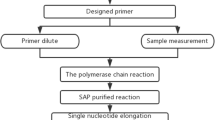Abstract
Essential hypertension (EH) is thought to result from the interaction of environmental and genetic factors. The molecular genetics of EH has witnessed considerable progress during the past few years. However, the number of genes involved, their chromosomal location and the magnitude of their effect on EH susceptibility are unknown. We conducted the present study to screen susceptibility genes to essential hypertension using a genome-wide scanning method in a group of Han people from Fangshan district located in the southwest of Beijing. A case-control study and affected sibpair were performed. Genotyping was carried out using a fluorescence-based semiautomated technique on automated DNA sequencer (ABI 377, PE). The basis for the genome-screen was the ABI prism linkage mapping sets of 400 microsatellite markers (version 2, PE, Co.). PCR for amplification of markers was carried out as multiplex reactions with Ampli Taq gold (PE, Co.) following protocols developed in our laboratory. Data were exported as a text file from genotyper for subsequent two-point affected sibpair linkage analysis. The data from case-control association study showed a linkage disequilibrium between EH and marker D1S249 locus (X 2 = 14.6,P = 0.002). There are 12 alleles in the D1S249 locus. The frequency of A9 allele in hypertension was higher than in normotensives, (13.6% v.s. 2.7%,X 2 = 6.30,p = 0.01, OR = 4.57, 95%CI = 1.24 – 25.4). The data from two-point affected sibpair linkage analysis demonstrated a linkage between EH and A9 allele,P<0.05. It suggested that microsatellite marker D1S249 locus might be associated with the genetic susceptibility to essential hypertension in Han Chinese.
Similar content being viewed by others
References
Jeunemaitre, X., Soubrier, F., Kotelevtsev, Y. V. et al., Molecular basis of hypertension: role of angiotensinogen, Cell, 1993,71: 169.
Hingorani, A. D., Sharma, P., Jia, H. et al., Blood pressure and M235T polymorphism of the angiotensinogen gene, Hypertension, 1996,28: 907.
Liu, Y., Zhou, W. Y., Qiu, C. C. et al., Association analysis of polymorphisms of ACE gene and AGT gene with essential hypertension in Chinese Han’s population, Chin. Med. Sci. J., 1998,13(2): 71.
Davies, E., Bonnar, D. A., Lathrop, G. M. et al., Human angiotensin II type I receptor locus, CA repeat polymorphism and genetic mapping, Hum. Mol. Genet., 1994,3: 838.
Kainulainen, K., Perola, M., Terwilliger, J. et al., Evidence for involvement of the type I angiotensin II receptor locus in essential hypertension, Hypertension, 1999,33: 844.
Wang, W. Y. S., Zee, R. Y. L., Morris, B. J. et al., Association of angiotensin II type I receptor gene polymorphism with essential hypertension, Clin. Genet., 1997,51: 31.
Mastana, S., Nunn, J., Angiotensin-converting enzyme deletion polymorphism is associated with hypertension in a sikh population, Human Hered., 1997,47: 250.
Poirier, O., Georges, J. L., Ricard, S. et al., New polymorphisms of the angiotensin II type I receptor gene and their associations with myocardial infarction and blood pressure: the ECTIM study, J. of Hypertension, 1998,16: 1443.
Liu, Y., Qiu, C. C., Zhou, W. Y. et al., Gene polymorphisms of the renin-angiotensin system in essential hypertension, Chinese Medical Journal, 1999,112(2): 115.
Todd, J. A., Genetic analysis of type I diabetes using whole genome approaches, Proc. Natl. Acad. Sci. USA, 1995,92: 8560.
Hanis, C. L., Boerwinkle, E., Chakraborty, R. et al., A genome-wide search for human non-insulin-dependent (type II) diabetes genes reveals a major susceptibility locus on chromosome 2, Nature Genetics, 1996,13: 161.
Hager, J., Dina, C., Franke, S. et al., A genome-wide scan for human obesity genes reveals a major susceptibility locus on chromosome 10, Nature Genetics, 1998,20: 304.
Schuster, H., Wienker, T. F., Bahring, S. et al., Severe autosomal dominant hypertension and brachydactyly in a unique Turkish Kindred maps to human chromosome 12, Nature Genetics, 1996,13: 98.
Baima, J., Nicolaou, M., Schwartz, F. et al., Evidence for linkage between essential hypertension and a putative locus on human chromosome 17, Hypertension, 1999,34: 4.
Wright, F. A., O’connor, D. T., Roberts, E. et al., Genome scan for blood pressure loci in mice, Hypertension, 1999,34: 625.
Cox, N. J., Baker, L., Spielman, R. S., Insulin-gene sharing in sib pairs with insulin dependent diabetes mellitus: no evidence for linkage, Am. J. Hum. Genet., 1988,42: 167.
Bonnardeaux, A., Davies, E., Jeunemaitre, X. et al., Angiotensin II type I receptor gene polymorphisms in human essential hypertension, Hypertension, 1994,24: 63.
Author information
Authors and Affiliations
Corresponding author
Rights and permissions
About this article
Cite this article
Zheng, Y., Qiu, C., Hou, S. et al. Evidence for association of D1S249 locus on human chromosome 1 with the susceptibility to essential hypertension in Han Chinese. Sci. China Ser. C.-Life Sci. 44, 106–112 (2001). https://doi.org/10.1007/BF02882079
Received:
Issue Date:
DOI: https://doi.org/10.1007/BF02882079




